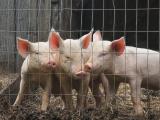Nov 18, 2010 (CIDRAP News) – The unusual spring emergence and summer activity of the novel H1N1 virus in 2009 led suspicions that its transmission pattern might vary from seasonal strains, but new research suggests that it was similar to seasonal H3N2 viruses.
A group from Mount Sinai School of Medicine in New York City, including virologist Dr Peter Palese, compared transmission patterns of 2009 H1N1 and seasonal H3N2 viruses in guinea pigs. Their findings appeared yesterday in an early online edition of the Journal of Virology.
In 2007 the same group showed that aerosol H3N2 transmission depends on cold and dry conditions. To compare it with the 2009 pandemic H1N1 virus, they ran several aerosol transmission experiments using several different environmental conditions.
For each series, experimentally infected guinea pigs were placed in the same environmental chamber with uninfected animals.
They found that both viruses transmitted well at 65% relative humidity and 20°C (68°F). When they increased the relative humidity to 80%, no transmission of the 2009 H1N1 virus occurred, and the H3N2 virus spread to only one of four exposed guinea pigs. Under dry conditions, transmission was lower for both viruses when the temperature was warmer.
Neither virus transmitted under warm and humid conditions.
The investigators concluded that the sensitivity of the 2009 H1N1 virus to temperature and humidity was similar to the H3N2 virus and that the unusual seasonality of the 2009 H1N1 virus did not relate to its ability to spread at higher temperatures and humidity. Instead, the population's lack of preexisting immunity probably played more of a role in the unusual seasonal circulation in summer and early autumn of the new virus, they suggested.
They noted that spring flu waves have been seen in previous pandemics, and epidemiologic models have shown that the availability of susceptible hosts is the key driver of transmission in populations
"Thus, perhaps in the absence of widespread immunity, the humidity and temperature requirements needed to achieve sustained transmission of influenza virus become less stringent," they wrote.
Steel J, Palese P, Lowen A. Transmission of a 2009 pandemic influenza virus shows similar sensitivity to temperature and humidity as an H3N2 seasonal strain. J Virol 2010 Nov 17, early online publication [Abstract]



















